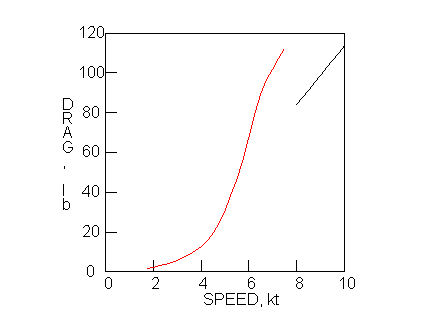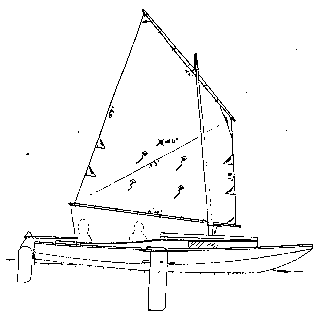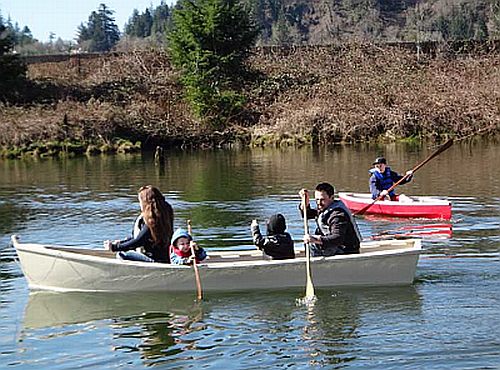BACK TO THE BOBSBOAT DESIGN...

Let's take a quick guess at its displacement using the prismatic
coefficient method discussed last time. We will put the draft at 9"
which is where the chines and stern will start to immerse. I would
expect the boat to go fairly well up until that point, then it will
slow dramatically. Here is the endview:

First we will construct a "prism" with a length as long as our
waterline when the draft is 9". I will estimate that as 18'. Then the
prism will have the same cross section as this boat's maximum
underwater cross section. So that cross section will have as shown
above a bottom 4' wide and a top 6' wide and a depth of .75' deep (9"
draft). That cross sectional area is .5x(4+6)x.75=3.75 sq ft. And the
total prism volume would be 3.75 x 18 = 67.5 cubic feet. Now apply a
"prismatic coefficient" of .55 as discussed in the last issue and we
would estimate a max useful displacement for Bobsboat of 67.5 x .55 =
37 cubic feet of water, which is 37 x 62 = 2300 pounds.
That I think is quite a lot. I would at this time estimate an empty
weight of the hull at perhaps 500 pounds and maybe another 100 pounds
for the motor. Add four adults at say 700 pounds total and you are
looking at about 1200 pounds total. So there is quite a surplus. One
thing I must remember is that this boat is to have its motor mounted
inboard in a slot that will eliminate a triangular shaped volume of
water that is 4' long, maybe 2' wide, and 9" deep which eliminates
about 180 pounds of displacement. Anyway, the important point is that
we have enough and if someone wants to take on more folks the boat
will handle it.
Always do this sort of calculation as soon as you can. For example if
this were to be a ballasted sailing cabin boat you might increase
hull weight to maybe 700 pounds and then add 700 pounds of ballast
and have a starting weight of 1400 pounds before adding any people or
gear. (It should still work.)
MIGHT AS WELL TRY A COMPUTER MODEL...
At this stage you will do well to make a computer model using
something like the Hullform program. You should be able to download a
free demo version of the program which will suffice for this work by
clicking on the Hullform link at the bottom of this web issue.
Hullform is not an "instant" sort of program. You will have to supply
it with the information needed to define the hull shape of your boat
- no program could do any serious work without that.
So I go back to the line drawings that I made a few issues ago and
measure offsets at every two feet, plus another set at station 11 of
this 20' hull so I have a section at the hull's maximum beam. Then I
call up Hullform and start a model and start plugging in those
offsets. Eventually you will get pretty good at it and be able to
knock out a useful model in a half hour or so. Here is my Hullform
model of Bobsboat:

Looks like a boat to me. The graphics will show you big goofs in your
offsets but maybe not small goofs. I'm not sure how fine the grid
needs to be but I'm quite sure that having ten or so stations is
plenty to get a good handle on the numbers. I did not model in the
motor slot but I'm sure it can be done. Hullform was I think meant
for serious ship design and is not challenged much by this small
boat. The version I use most was written for DOS, that is it is older
than Windows. It runs very quickly on any computer. I would suspect
the newer versions require more power and have a lot more graphics.
But even the free demos will allow you to see your hull in three
dimensions, even will shade things to a certain degree, like this:

And this:

Still looks like a boat to me and I see no need to change anything.
PUTTING HULLFORMS TO WORK...
Pictures are nice but Hullform will do some real quick work for you.
Again you need to supply it with all the info it needs to do that
work, such as weight and center of gravity. At this stage you will
have to guess at those.
So I used the above model to check on the displacement calculations.
Essentially you tell Hullform the boats weight and cg location and it
will tell you the draft needed and how much the boat is pitching.
Usually we want the boat to sit level when loaded so I found by a few
trials that this hull wants its weight centered 11' from the bow to
float level. That is fine since it is also the max beam location.
(The real boat, with the motor slot, will want its weight more
forward.) Once you have that cg location for level trim you can plug
in a few weights and just read off the resulting drafts. Here is what
I got for Bobsboat:
500 pounds - 3.4" draft (probably the weight of the empty boat).
800 pounds - 4.5" draft (probably the minimum operating weight with
skipper and motor).
1000 pounds - 5.2" draft
1200 pounds - 5.8" draft (a good maximum weight, say four adults on
board).
2400 pounds - 8.96" draft (is that close to our first guess or what!)
I should add that at this point the program has not really solved
much that we weren't able to figure by hand quickly. But Hullform
will also very quickly solve the problem of righting moments at
various angles of heel and that if done by hand is almost a life's
work. Doing those calculations by hand is so tedious that essentially
it was never done for small boats. In the example Bobsboat, which
should also be a fine sailing hull, the program would also need to
know the vertical cg location. Once supplied with the hull shape and
the total weight/cg situation, Hullform will crank out a full
righting moment graph in a few seconds! (But don't get the idea that
you can supply it with a weight/cg estimate in a few seconds.)
ANOTHER FEATURE...
that I noticed in the newer demos is the ability to give a chart of
drag/speed for your proposed hull. I'm don't really know the source
of the math behind the estimates. You may recall that a couple of
years back I built a "Thrustometer" and measured the thrust of a few
of my outboards while they were pushing my AF4. Then I compared those
thrusts to the Hullform estimates. The comparison was OK, a good
starting point I think. Here is the proposed chart for Bobsboat:

When I look at this I see what all slow speed hulls experience - a
"hull speed". As you see, drag rises very quickly at about 5 knots.
The usual estimate for "hull speed" in knots is something like 1.3
times the square root of the waterline length (in feet). So if we had
an 18' waterline then we would estimate 1.3 x sqrt18 = 5.5 knots. And
the above chart sort of agrees with that. I'm not sure if we have
gained a lot of new information but it is worth while to look at.
Hullform will make curves for a range of weights (the above is for
1200 pounds).
Some day I'd like to be able to use the above charts to get a handle
on horsepower requirements, a task we tried back with the
Thrustometer. If you look at the above there would be a temptation to
say, "Hey, a 30 pound thrust trolling motor will push this at 5
knots." And that might be true. But in any breeze the wind drag will
quickly outrun the water drag and you will get nowhere or go
backwards. From my experience with Birdwatcher, the answer to
powering all boats like this is that you need between three and five
hp. BW went 6mph with my 3.5 Clinton wide open and about 6mph with my
5.5 Johnson wide open. From the above chart you can see why - the
slope of the drag curve is so steep at the "hull speed" that a lot
more power gives only a little more speed. That would be true until
the boat starts to "plane". In the above chart you see the black line
which is the start of the planing line. Somewhere in between the red
line and the black line there is a transition. But a hull with a fine
stern like Bobsboat or Birdwatcher really won't plane well at all as
far as hull trim and controlability are concerned and you should not
think of planing that type of hull. The extra power of the 5.5 on
Birdwatcher has a real advantage in that I can run at say 4knots at a
whisper quiet third throttle in calm conditions and still have some
extra to fight the bad conditions.
When we come back to Bobsboat in April we will start the hard core
drafting - determining the prefab shapes of the panels.
Contents
FROLIC2

FROLIC2, CUDDY MULTI SKIFF, 20' X 5', 400 POUNDS EMPTY
The photos show the prototype Frolic2 built by Larry Martin of Coos
Bay, Oregon. Larry built the boat quite quickly this past winter
including sewing the sail to the instructions given in the plans.
He reported sailing it for the first time on a ripping day with an
occasional 2' wave. I always advise testing a new boat in mild
weather, especially a new design, but Larry got away with it.
Looking at his photos, the neat work, and simple efficient rigging
suggests to me that Larry has been sailing small boats a long time.

Frolic2 has a small cabin, probably only for one to sleep in
because the multichines that make the boat good in rough water also
rob you of floor space. To say it another way, the nice big floor
space of a flat bottomed sharpie is what pounds in rough water and
makes you uncomfortable. But Frolic2 has a 6' long cockpit so
someone could sleep there too. There is bench seating. The cabin
top has a slot top down the center and you can stroll right through
the cabin standing upright in good weather and out the front
bulkhead to the beach. The mast is offset to one side so you will
need not have to step around it. Phil Bolger showed us how to do
this about 15 years ago and it works. But Larry went conventional
with his boat, mounting the mast on centerline and decking in the
front of the cabin. On a slot top cabin you use a simple snap on
tarp to cover the slot in rain or cold or bugs.

Frolic2 was designed for rough water, long and lean, especially in
the bow, and with multiple chines. She's really a takeoff of my
Toto canoe in shape. Larry omitted the motor well you see in the
lines, and the oarlocks too (The wind must blow just right all the
time in Oregon?) but I intended this to be a multi skiff sort of
boat with rowing and motoring abilities. You can't row a boat of
this size in any wind or waves but in a calm you can travel far if
you have patience. I didn't fool around with a gadget motor mount -
I put the motor well right in the middle and offset the rudder
instead of the other way around. This worked out very well on the
high powered Petesboat. We'll see how it goes on a narrow boat
because the second prototype is getting the blueprint well as you
see in the photo below of the Colorado Frolic2 still being built.
You need little power on a boat like this, 2 or 3 hp is more than
enough.

The lug rig is for quick easy stowing, rowing, and towing. (The
blueprint sail is actually the same size and shape as that of a
Bolger Windsprint, a boat which weighs maybe a third as much as
Frolic2 and is much narrower. But I think the Windsprint might be
over sparred for its size and weight.) Larry reports the rig is about
right for the boat, sailing fine with a reef in and three adults on a
windy day. The lug sail can be closer winded reefed than when full,
perhaps because the sail is then shorter and the yard better
controlled (less sail twist). For that matter a sharpie sprit sail
the same size as the lug might be smarter in rough water conditions
if you can live with the long mast. Switching rigs won't be hard. The
mast can be relocated almost anywhere in the slot top without
altering the hull to any degree. You just need extra partner and step
fittings.

Update, 2006. Jeff Blunk's Colorado Frolic2 eventually found its
way to Illinois and then to our Rend Lake Messabout in the hands of
Richard Harris. We had a chance to try it out and I was quite
pleased. It was fast and powerful. At one point with three men on
board, with Max at the tiller, I went forward to tweak the sail
which took a couple of minutes with me staring up at the sail. That
done I looked back and saw that we were really rolling along.

And Gary Blankenship's Frolic2 completed the Everglades 300 mile
challenge with him reporting sailing for hours at 7 knots or more.
Last count he completed five of the challenges with a 4th overall
in 2007 and 7th in 2012. Here is Gary's Frolic2 on the launch pad
just before the start. Note the row of fenders mounted on the cabin
to be used as beach rollers but also as capsize protection since
boats like this can swamp if the cabin is not well corked and there
is weight forward.:

And then the actual race launch, that is Gary showing us his
backside with crewman Chuck The Duck Leinweber:

I should add that the little mizzen is Gary's addition and is quite
valuable on a long cruise, and by my experience usually a bother
for a short daysail. Although Gary has never used a motor on his
Frolic2 he still retains the well and saw no need to change the
offset rudder.
Construction is with taped seams from eleven sheets of 1/4" plywood
and two sheets of 1/2" plywood.
Plans for Frolic2 are $35.
Contents
Prototype News
Some of you may know that in addition to the one buck catalog
which now contains 20 "done" boats, I offer another catalog of
20 unbuilt prototypes. The buck catalog has on its last page a
list and brief description of the boats currently in the
Catalog of Prototypes. That catalog also contains some articles
that I wrote for Messing About In Boats and Boatbuilder
magazines. The Catalog of Prototypes costs $3. The both
together amount to 50 pages for $4, an offer you may have seen
in Woodenboat ads. Payment must be in US funds. The banks here
won't accept anything else. (I've got a little stash of foreign
currency that I can admire but not spend.) I'm way too small
for credit cards.
I think David Hahn's Out West Picara is the winner of the
Picara race. Shown here on its first sail except there was no
wind. Hopefully more later. (Not sure if a polytarp sail is
suitable for a boat this heavy.

Here is a Musicbox2 out West.

This is Ted Arkey's Jukebox2 down in Sydney. Shown with the
"ketchooner" rig, featuring his own polytarp sails, that is
shown on the plans. Should have a sailing report soon.

And the Vole in New York is Garth Battista's of
www.breakawaybooks.com, printer of my book and Max's old
outboard book and many other fine sports books. Beautiful job!
Garth is using a small lug rig for sail, not the sharpie sprit
sail shown on the plans, so I will continue to carry the design
as a prototype boat. But he has used it extensively on his
Bahamas trip towed behind his Cormorant. Sort of like having a
compact car towed behind an RV.

And a Deansbox seen in Texas:

Another prototype Twister is well along:

And the first D'arcy Bryn is taped and bottom painted. You can
follow the builder's progress at http://moffitt1.wordpress.com/
....

Contents
AN INDEX OF PAST ISSUES
A NOTE ABOUT THE OLD WAY BACK ISSUES
(BACK TO 1997!). SOMEONE MORE CAREFUL THAN I HAS SAVED
THEM. TRY CLICKING ON...
http://web.archive.org/web/20050308025339/http://marina.fortunecity.com/breakwater/274/michalak/alphabetical.htm
which should give you a saving of the
original Chuck Leinweber archives from 1997 through 2004.
They seem to be about 90 percent complete.
BACK ISSUES
LISTED BY DATE
SOME
LINKS
Mother of All Boat
Links
Cheap
Pages
Duckworks
Magazine
The Boatbuilding
Community
Kilburn's Power
Skiff
Bruce Builds
Roar
Dave
Carnell
Rich builds
AF2
JB Builds
AF4
JB Builds
Sportdory
Hullforms Download (archived
copy)
Puddle Duck
Website
Brian builds Roar2 (archived
copy)
Herb builds AF3 (archived copy)
Herb builds RB42 (archived copy)
Barry Builds
Toto
Table of
Contents





















